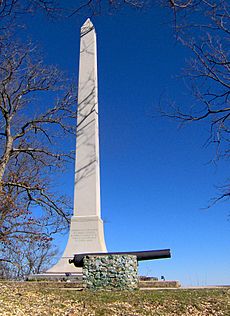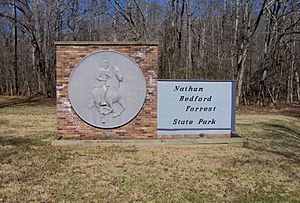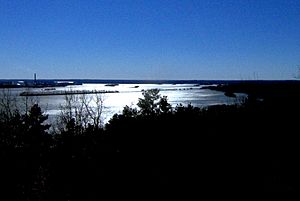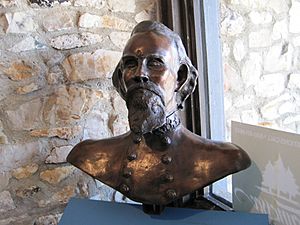Nathan Bedford Forrest State Park facts for kids
Nathan Bedford Forrest State Park is a fun state park located in Benton County, Tennessee. It's in the southeastern part of the United States. The park sits right on the western side of Kentucky Lake. This lake is actually a wide part of the Tennessee River. You'll find it just north of a small town called Eva.
This park was created in 1929. It covers a huge area of 2,587 acres (10.47 km2). The Tennessee Department of Environment and Conservation takes care of it. The park is named after Confederate General Nathan Bedford Forrest (1821–1877). He was active in this area during the U.S. Civil War. The park includes part of the land where Forrest fought in the 1864 Battle of Johnsonville. In this battle, he attacked a Union supply base across the river.
Besides the battle site, the park has cool features. One is Pilot Knob, a hill that is 656 feet (200 m) high. It's one of the tallest spots in West Tennessee. There's also the Tennessee River Folklife Center. This center teaches visitors about life in the lower Tennessee Valley long ago.
Contents
Exploring Nathan Bedford Forrest State Park
Nathan Bedford Forrest State Park is a great place to visit. It offers beautiful views and a chance to learn about history. The park is known for its connection to the Civil War. It also highlights the natural beauty of the Tennessee River.
Where is the Park Located?
The Tennessee River flows into the Benton County area from the south. It then heads northwest towards the Ohio River. Kentucky Lake was formed when the Kentucky Dam was finished in 1944. This lake covers a 184-mile (296 km) stretch of the river. Nathan Bedford Forrest State Park is on the western side of Kentucky Lake. It's about 80 miles (130 km) upstream from Kentucky Dam.
Pilot Knob is the highest point of a ridge. This ridge stretches about 3 miles (4.8 km) to the northwest. Most of the park has hills and valleys. These run in the same direction as Pilot Knob Ridge. The park's main offices are on the slopes of Pilot Knob. The Tennessee River Folklife Center and hiking trails are at the top.
You can reach the park by taking State Route 191. This road ends at the top of Pilot Knob. It connects the park to major highways like Interstate 40 and U.S. Route 70 to the south.
A Look Back in Time
People have lived in the Benton County area for at least 7,000 years. In 1940, archaeologists found an ancient site near the park. It was from the Archaic period (8000-1000 BC). This site, called the Eva site, is now under Kentucky Lake. At the Eva site, experts found many old tools and human burials. These dated back to around 5200 BC. The area was also used during later periods.
When European settlers arrived, several well-used paths crossed the area. The Tennessee River was shallow here, making it a good crossing point. Old trails like the Cisco and Middle Tennessee Trace ran north to south. Another trail, the Lower Harpeth and West Tennessee Trace, ran east to west.

The Battle of Johnsonville
In the fall of 1864, during the U.S. Civil War, General William T. Sherman captured Atlanta. He then planned to march south. To stop him, General John Bell Hood tried to cut Union supply lines in Tennessee. General Nathan B. Forrest moved northeast from Corinth, Mississippi. He reached the Tennessee-Kentucky border on October 28. Then he moved south along the river.
In early November, Forrest secretly placed his cannons. They were on the west bank of the river. This was across from the Union supply base at Johnsonville. Most of Forrest's actions were near the modern Eva boat ramp. But he also put two cannons on Pilot Knob. This spot gave him a clear shot into the Union fort.
Johnsonville was a key supply point for the Union army. Huge amounts of food and weapons were stored there. They were moved from boats to trains. The area was strongly protected by 2,000 Union soldiers and gunboats. But when Forrest attacked on November 4, the Union commanders panicked. They feared Forrest would take the fort. So, Union troops burned their own boats and supplies. They tried to escape by train.
Forrest was able to get back to Corinth before Union help arrived. The Union lost 8 soldiers and 150 were captured. Forrest reported 2 dead and 9 wounded. The Union forces lost millions of dollars in supplies and ships. A rumor that Forrest was moving north caused fear among Union troops. The site of Johnsonville is now protected by Johnsonville State Historic Park.
How the Park Was Created
Much of the park's southern land once belonged to the Pafford family. They arrived in the mid-1800s. The Paffords held big Independence Day parties near the park entrance. People from all over the county came. Even famous Grand Ole Opry performers would visit. The Paffords helped General Forrest during the Battle of Johnsonville. Later, they became the park's first caretakers.
In December 1929, Tennessee created Nathan Bedford Forrest Memorial Park. The Paffords donated the land on Pilot Knob. A road was built to connect Eva with Pilot Knob. A granite monument was also put up there. In the 1930s, groups like the Civilian Conservation Corps and Works Progress Administration helped. They built the park's roads, trails, and buildings.
Park Fun and Facilities
Nathan Bedford Forrest State Park has many things to do. You can rent one of seven cabins. There's an RV campground and two simple campgrounds. A large lodge can hold 64 people. There are also three boat ramps for water fun.
The park has about 30 miles (48 km) of hiking trails. Most of these trails are part of a 20-mile (32 km) loop. You can take shortcuts to make your hike 3, 5, or 10 miles long.
Tennessee River Folklife Museum
The Tennessee River Folklife Museum is at the top of Pilot Knob. It's at the end of State Route 191. This museum teaches about the lives of people along the lower Tennessee River. It focuses on the late 1800s and early 1900s.
The center has audio and video recordings. You can see old tools used for collecting mussels. There's even a real 1950s jon boat. The museum also has a small nature center. It shows fish and reptiles that live in the area.
Images for kids






